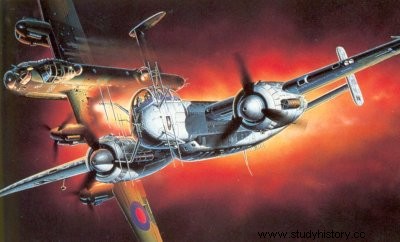The following episode describes the first combat mission of the Heinkel He 219, a night fighter nicknamed "Uhu" (Grand Duke) in the Luftwaffe. Night fighter ace and group commander in
Nachtjagdgeschwader 1, Walter Streib flew the first wartime mission on He 219 in June 1943. After taking off from Venlo, Netherlands, he scored five victories in what turned out to be
the most successful of all the Uhu's, and one of the conflict's most remarkable night fighters.
Translated from the original story, published in German in Aces High, by Constable, and published by Toliver.

Streib was still the commander of I./NJG I when the first He 219s arrived at Venlo. The mechanics prepared the long-awaited machines with feverish enthusiasm. The He 219 had been practically their only topic of conversation for the previous months. When Streib took off on the new night fighter on the night of June 11, 1943, Heinkel factory personnel and the men of NJG 1 felt that a new era was dawning for night fighters. They were right.
Accompanied by Sergeant Eischer, his radar operator installed in the rear of the cockpit, Streib slipped easily into a noria of R.A.F. bombers. on the way to Berlin. His fast fighter allowed him to circle around the heavy Lancasters. In addition, the firepower of the Uhu was fantastic.
Four 30 mm guns housed in a pod under the fuselage and two more 20 mm mounted in the wing-fuselage fittings gave the aircraft enormous destructive capacity. A short, well-aimed burst was enough to send the heaviest machine to the ground.
Streib flew for half an hour in the stream of bombers. Based on the headings transmitted to him by Fischer, he moved closer and closer and, when he was within range, fired his six guns.
The latter being under the fuselage, the gleams caused by the shots could not therefore disturb the night vision of the pilot. The concentrated bursts did not miss their targets. The bombers exploded one after the other or fell in flames, carried away by their ten-ton mass, veritable flaming coffins for their ten crew members.
Half an hour after entering the Lancaster noria, Streib had shouted five times "Pauke!" Pauke! (victory cry of Luftwaffe night fighters). These five victories were all confirmed by ground radar control. The victorious plane did not suffer the slightest scratch during these fights, apart from a film of opaque oil on the windshield, coming from one of the Merlin engines of a downed Lancaster whose propeller had projected the liquid viscous towards Streib's machine.
This nimble machine had proven itself capable of dodging the fire of dozens of R.A.F. bomber machine guns. Streib had carried out his attack in a masterful way and felled his adversaries without having to expose himself to their reactions.
There were no problems until the moment Streib began his return flight to Venlo airfield. There, he couldn't get his shutters out, and the layer of sludge covering the windshield made the situation even more dramatic. Forced to make his approach at more than 160 km/h and in a dark night, Streib damaged his brand new Uhu.
He completed his mission in Hollywood style, separating his cabin from the rest of the plane. Still harnessed, Streib and Fischer made a short involuntary flight when their cockpits slid down the runway before coming to rest in the grass.
They left their plane dazed, but triumphant and unscathed . Reports of the five downed bombers were quickly routed to Venlo. The He 219's baptism of fire may have ended in a sorry way, but there was no doubt that the new fighter would keep all its promises in air combat.
